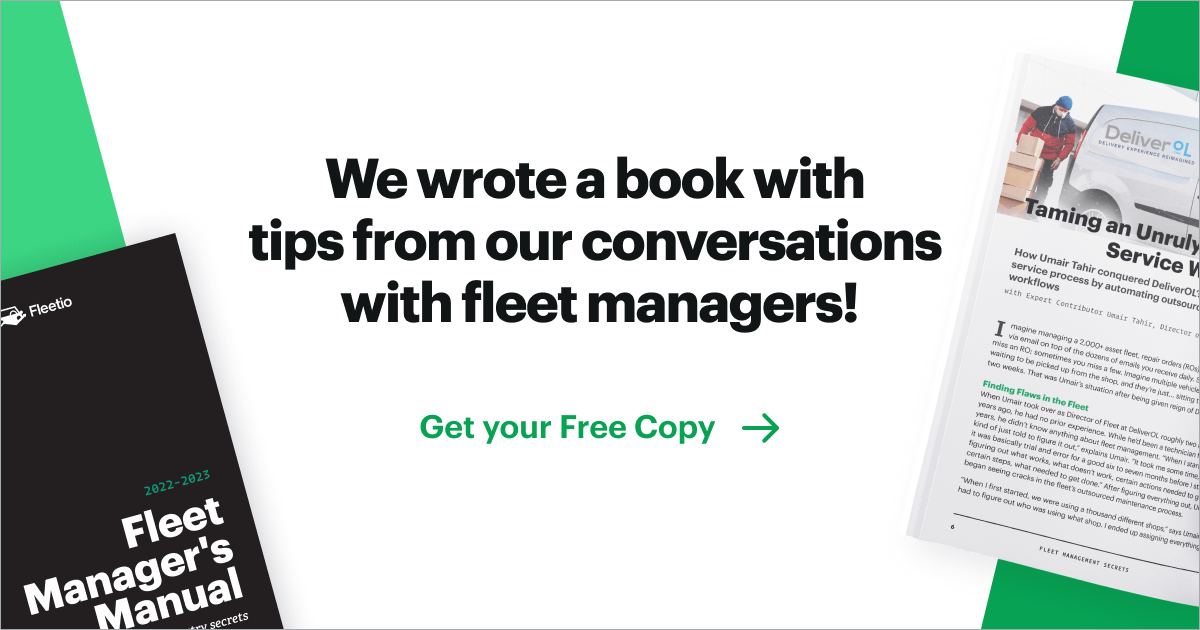We sat down with fleet vet Tom Rowlings to talk about how he’s managed implementing Fleetio in his municipal fleet, and we’ve compiled some tips for fleet managers looking to introduce new solutions to their organizations.
Fleet technologies are designed to make a fleet manager’s job easier, but clearing the hurdle of implementation can be a tricky process that makes or breaks the experience with a fleet management software long term.
It’s a process Tom Rowlings knows well. Over the past 20 years, he’s been involved in the implementation of numerous fleet technologies, whether as a mechanic learning his way around a program for the first time or as a manager trying to scale a pen-and-paper operation. Now, as the assistant fleet manager for the City of Cambridge, Massachusetts, he’s leveraged his previous experiences to create a seamless transition to fleet software, from training mechanics and drivers to getting buy-in from higher-ups.
Here are some of the biggest takeaways from our conversation with Tom about finding success in implementing new fleet technologies:
1. Look for the right features in the software you choose – not just cost.
"Most fleet softwares have similar functionalities in what the end result is, but it’s how you get to that end result and how user-friendly the interface is. I have to have a mobile app, given the world we’re living in, and it has to be able to integrate with other softwares, specifically telematics or GPS softwares and fuel management software.
"Cost was not anywhere in my research equation. I didn’t even factor in cost until I found a couple of softwares that would actually function the way I wanted them to."
2. Understand the technology and your fleet’s resources.
"The implementation has to be based on what your expectation of technology usage is. It’s different if you’re using an iPad versus a computer, and you have to be aware of that in the way you train. The way I see things on my computer, and the way the guys see stuff on a tablet – it is different.
"I have my own tablet. I have an administrator account, and I have a mechanic account. On the tablet, I use the mechanic account, so that I can log in and see how the guys are seeing it with their permissions. So I make sure I’m not blindly sitting in my office saying, ‘Oh, you guys can do this,’ when it’s different on the desktop version."
3. Ditch the slideshows and get hands-on.
"What a lot of people tend to do is sit everyone in a room in front of a Powerpoint presentation and say, ‘This is how you’re going to do it.’ Have you ever seen a mechanic take notes? It doesn’t happen. Mechanics spend so much time on the floor, under a truck, that they don’t necessarily want to sit in a conference room. They’re only there for the bagels and donuts."
"My method is ‘lack of training’ – cut back on the Powerpoints and the ‘This is how you’re going to do it,’ and tailor the training [to your mechanics]. I took the approach where, right off the bat, we were utilizing tablets and it has the Fleetio Go app. I did more of a, ‘Jump on in everybody, the water’s warm. Here’s your tablet.’ I showed everybody how to log in, and I said, ‘Take the next couple of days and get familiar with it. I want you to poke around and figure out the same way as when you downloaded TikTok on your phone to look at videos.’"
4. Be flexible in the way you train by tailoring it to your team.
"Five out of six of my guys are very tech-savvy mechanics, so that approach made the most sense given the skill level of the guys I had. Now, the sixth guy, I definitely had to spend a lot of one-on-one time with him. But in doing so, it helped me tailor the process, so instead of me saying, ‘I want you to do it my way,’ I could take the feedback from the guys to then refine our overall process of doing repair work, work orders, how they’re opened, who can open them."
5. Set the right expectations with your higher-ups.
"In companies both public and private – and in municipalities – a fleet is often overlooked, the red-headed stepchild, so to speak. We’re a cost center. We cost a company or municipality a lot of money. When you’re spending millions of dollars in repairs to vehicles, in parts, in service, and you need something as a support mechanism such as software, it’s hard to get the funding for it.
"You have to make sure that your leadership above you understands your expectations of time, that they’re not thinking, ‘Hey, you have this new program, we’re three days in, let me see those cost savings reports and where you spent all your money this month.’ You have to set the expectations and have a leadership that understands that it takes time to implement a new technology, and you’re not going to get that automatically.
"You have to explain, ‘I know it’s a lot of money, but in order for you to get the payback you’re looking for, we have to make sure we do this the right way.’"
6. Get buy-in from the whole organization by demonstrating value.
"A lot of [getting buy-in] comes down to convincing them of the functionality of the technology. I put my salesman hat on and I sat in front of everybody and brought the program up on the screen and said, ‘It can do this, this and this.’
"One of the things was that I can give access to the individual department heads [of the City of Cambridge] to see their vehicles and to see when things are due for preventive maintenance. Instead of sending me an email with a list, they can open the app and quickly throw in an issue for one of their trucks. It doesn’t matter if I’m on vacation, it’s in there.
"Really, convincing everybody was a lot more of seeing the functionality than it was even a discussion about cost."
7. Listen to your team and remember that you don’t know everything.
"It doesn’t matter what industry – in life in general, if you’re a manager that is going to say, ‘You’re going to do what I’m telling you to do because I’m the boss,’ then you are not going to be successful in implementing even the greatest of technologies out there.
"You have to be open and know that, ‘I consider myself to be a fairly intelligent individual, but you know what? These guys that work for me are not idiots.’ They got to where they are because they can perform their jobs well. Listening to them is extremely important. Hear them out with whatever it is – ‘Hey, we’re going from paper and pen to technology, what are some of your requests? What would you like to see?’"
See more from our conversation with Tom in our City of Cambridge case study.
Experienced fleet managers like Tom trust Fleetio to support them through implementation and beyond as they streamline their operations. Schedule a demo or sign up for a free trial today.




